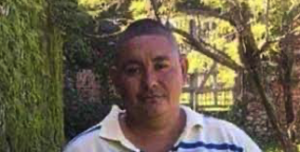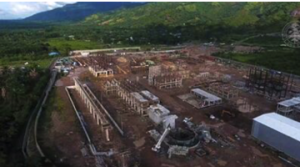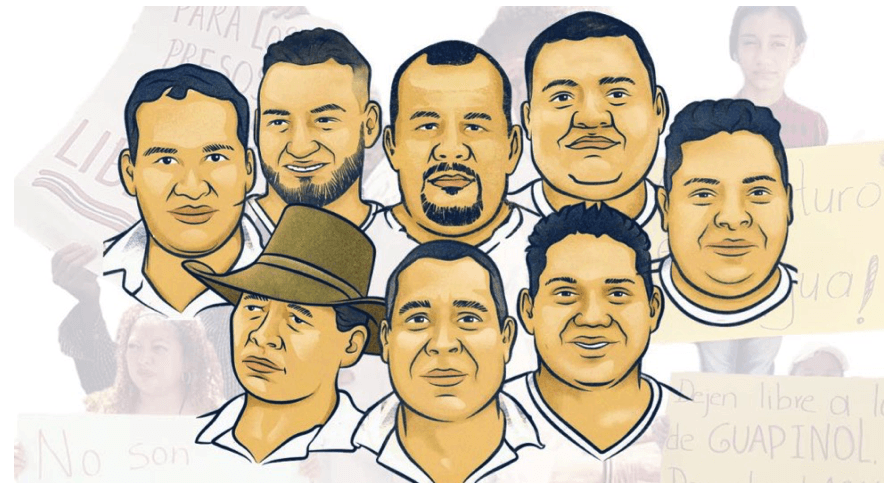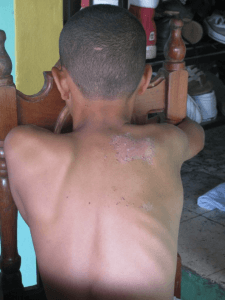In April this year [2018] Rights Action published an article entitled ‘Goldcorp’s Valley of Death in Honduras’. The article was written by Martin Calix under the heading ‘The Valley of Despair’ for ContraCorriente, a digital media for journalism in Honduras producing in-depth articles on the reality of life in Honduras and in the region. The original article in Spanish can be accessed at: https://contracorriente.red/2017/10/05/el-valle-de-la-esperanza/
Martin Calix is a Honduran writer and author of several books such as ‘Partiendo a la locura’ (2011), ‘45’ (2013), ‘Lecciones para monstruos’ (2014) and ‘El año del armadillo’ (2016).
For Rights Action the article was translated by Lori Berenson.
The article relates to the legacy of Goldcorp’s mining in the Siria Valley, Honduras. For myself and ‘The Violence of Development’ website, the article brought back memories of a short interview I conducted in 2009 with Purificación Hernández of ASONOG about changes to the Law of Mining in Honduras at that time. This has relevance to the contamination caused by Goldcorp’s mining activities in the Siria Valley of Honduras which is the subject of the article, but for some reason it had not been uploaded onto the website at an earlier date. So, this month’s additions to the website include the Spanish version of the 2009 interview and the English translation – rather belatedly.
The much more recent article by Martin Calix follows. I am grateful to ContraCorriente for permission to reproduce the article here.
The Valley of Despair

By Martin Calix, Published 4 April 2018
Acid rain is not a myth. The inhabitants of the Valley of Syria, located about 120 kilometers from Tegucigalpa, know it well. The communities of Cedros, El Porvenir, and San Ignacio – three municipalities in the easternmost part of the Francisco Morazán department – were affected by the Canadian mining company Goldcorp Inc.’s open pit mining, another variant of the extractivist model. With the contamination of the waters of their rivers, the rain had to fall at some point, like a biblical prophecy.
The voraciousness of an extractivist model that is causing poverty and sickness for generations has led to an imminent moral collapse. The idea that mining companies are merciful and bring economic development is as easily demystified as a straight line of domino pieces must fall.
Cristi lives here. She is eighteen months old. She doesn’t know that she is sick, she doesn’t know that her hair is falling out. She is completely unaware that a future filled with uncertainty awaits her.
Aneli is Cristi’s mother. At 18 years of age, she is also losing her hair. Their health problems began at birth. Both were born ill, they were born with the brand of mining companies within their bodies, a brand that came to the valley at the beginning of 2000 and installed itself in the waters of the rivers and water sources that the valley communities have always used. They used the waters from these rivers well before Goldcorp Inc. arrived. They used the water during the eight years of mining exploitation at Goldcorp’s San Martin Mine, and they continue to use it during the seven years following the mine’s closure.
This closure was regarded as highly irregular by many human rights organisations such as OXFAM, the Honduran Centre for the Promotion of Community Development (CEHPRODEC) and the Institute of Environmental Rights of Honduras – and by affected communities.
In 2002, the “Minerales Entre Mares de Honduras” mining company (subsidiary of Goldcorp Inc.) extracted 129,435 ounces of gold which meant the removal of approximately 2.5 million tons of earth in just 12 months. Multiply this by their 8 years of operations.
Taking into account that in 2002, the price of one ounce of gold was 310 dollars – it is presently more than $1,200 –, the company’s income in that year (2002) is estimated in 40.1 million dollars, with a payroll that covered fewer than 200 employees.
According to Honduras’s Mining Law, mining companies only pay 6% of their total exports in taxes, an amount that does not suffice to repair the environmental damages caused by this activity.
The Goldcorp mining company, which also has projects in Mexico, Guatemala, Argentina, Dominican Republic, Canada and the United States, exploited fourteen thousand one hundred hectares in the Siria Valley area, and although the company declared the closure of the San Martin mine in 2008, they have other concessions approved for exploitation for a total of four thousand four hundred hectares in the municipalities of Mapulaca, Lempira (1,700), Distrito Central, Francisco Morazán (1,400), and Marcovia, Choluteca (1,300), according to information revealed by the Observatory of Natural Assets and Human Rights.
–Have you taken her to the doctor?
–No, and she stops speaking. Aneli doesn’t talk much, just one syllable responses. She says “no” and returns to her self-absorbed state – perhaps provoked by the camera, or perhaps provoked by having to respond to an outsider – and her loving gaze focuses on her daughter’s face.
Oneida, the mother of Aneli and grandmother of Cristi, might be sick too. She doesn’t say so, there’s no need. Her children were born sick because she consumed the water that had been contaminated by heavy metals. She seems to be more interested in understanding my family origins, where my last name is from, since there are people in her home town, Pedernal, with the last name Cálix. She hides from my questions and the camera. I don’t try harder. I know that I have invaded the fragile daily lives for her and her family.
The women from the Siria valley were always invisible. They were never included in any statistical charts, none, except maybe for the electoral census. Women like Oneida, or Aneli, have been relegated to fulfilling their eternal roles: caring for children, doing housework, being devoted housewives who take care of their husbands. Their husbands and sons, campesinos transformed in workers-miners with the advent of mining in the area, became the fundamental building block of a company that would convert their communities into lands inhabited by desolation.
The exact same thing happened in San Ignacio. Other women would say the same thing. That the only things that multiplied in their lives were severe illnesses. In San Ignacio, the case of five women affected by contamination has been documented. Some of these women had been involved in cleaning and cooking for the company, and others doing the same in their homes. Five women who had to face surgery to have their uteruses removed. It was that or death.
–What did they tell you?
–Nothing. They just removed it.
Sulay is 52 years old. She has a deep gaze and an evasive smile. She is one of the five. Her body was contaminated by lead, arsenic and thallium she says, because she washes the clothes of her husband who used to work in the mine. Miguel, her husband, arrives on horseback. It’s a good day – he was able to ride “Clown”, a white horse that is a cross between a Spanish horse and a Peruvian mare – after having spent four months unable to do so, due to a problem in his spinal column. “Clown” dances, follows him wherever he goes, and pretends to sleep. The horse seems to enjoy this relationship as much as Miguel does, which I observe but fail to understand from afar.
Miguel is one of the thirty-five former Goldcorp Inc. (Entre Mares) workers who joined together in 2009, after the San Martin mine closed its operations. They came together to ask for compensation from the Honduran government for their health problems, since Goldcorp failed to give it to them. Now they are suffering illnesses that have deteriorated their bodies due to exposure to contamination during the gold and silver extraction process. Spinal columns with arthritis or displaced discs, and different types of cancer are part of the general clinical picture narrated by these former miners, who also report that others have already died.
It is hard to calculate the number of cases of women who had miscarriages due to contamination – said the former miners and their partners. They say they were seen by the Honduran Social Security Institution but they lost their files there. They were then seen in the Viera Clinics, where their records were changed, to make it seem that they were healthy. Other analyses were done by an Italian scientist they told me about, but they do not show me any medical results, as if it were enough to give an oral version in a country where we only believe what we see – and what we see is a deep abyss.
Miguel had operated heavy machinery, those huge dump-trucks and back loaders that you see in magazines, in National Geographic programmes and on the Internet. And he shows me one of his fellow workers in a photo he found through google on his cell phone. They laugh, and it’s not clear why they laugh. They don’t know it, but in some ways, they had learned to be miners. They liked it. It gave them dreams. It gave them the hope of getting their families out of poverty.
Rolando puts away the cellphone with the pictures of the dump truck. He says that almost the same thing is happening to him. His spinal column has weakened with time, and at 47, there are days in which his body does not function, and he must stay in bed.
– My blood pressure is always at the point of giving me a heart attack, and he inhales his cigarette and answers a phone call that distances him from the conversation.
Marilu is Rolando’s wife and she is also ill. She has headaches and her back hurts. She explains that her daughters have respiratory illnesses that can’t be cured. They say that these are the types of illnesses that the doctors don’t explain much of anything about.
In the community of San José de Palo Ralo, a few kilometers from the urban center of San Ignacio – although “urbanity” is more of a euphemism to describe a couple of paved streets — is where two women, two sisters live: Maritza who is 28 and Maria who is 41. Both are single mothers. While pregnant, both consumed contaminated water from a well built by the mining company with the authorization of the Secretary of Natural Resources, on the property where their entire extended family lives, a family with many women and small children. There are older men, and some young people, but most have decided to put their bets on the American dream, and they have left already, years ago they started to leave.
Maritza and Maria are the mothers of children who were born sick. Jefferson, Maritza’s son, has respiratory problems. Maria’s son Anthony has a growth problem, a problem speaking – I don’t understand it well but his mother gets lost in a labyrinth trying to understand his speech—and he was also born with physical disabilities that don’t allow him to walk, although Maria is hopeful that it can be resolved with an operation.
Anthony and Jefferson –both age six—stopped going to the doctor. They lost access to their doctors’ appointments because their mothers couldn’t handle the cost of traveling to Tegucigalpa from their community in a small hamlet of San Ignacio. Maritza couldn’t keep paying the one thousand two hundred Lempiras ($50) in transportation costs so that her son could be cared for in the Teaching Hospital.
–The Valley means life for us, but for some organisations it means coming, taking some pictures, because that’s the possibility of justifying some budgets. People are tired – someone tells me, explaining that I can put on paper what they said but not give names. I promise that person, that I won’t tell, but by their expression I understand that they don’t believe me.
The women in the Siria Valley were always invisible. They were never included on any statistical chart. Goldcorp Inc. only hired a few of them to take care of domestic chores for the company’s foreign executives. To wash their clothes. To cook for them. To maintain clean the lodging house that has now been transformed in the San Martin Tourism Centre, that costs forty five dollars a night, and no guest, for any reason, can bring a camera to take photos or videos.
–It is prohibited to take pictures.
–And what is fun about the place?
–I don’t know. I just know that they don’t let you take pictures.
- Goldcorp video (3 minutes): “Goldcorp’s San Martin Mine Reclamation in Honduras”: https://www.youtube.com/watch?v=M633xeOOvlI&feature=youtu.be
- Rights Action comment: Please watch this corporate propaganda film that contrasts grotesquely with the reality on the ground, as documented in this article, film, and elsewhere.
At some point, because nobody remembers dates well in a shared history with much greater implications than the notion of time, the Environmental Committee of Siria Valley denounced water contamination in the rivers that cross through the valley, justifying the accusation in testing done on the water.
In 2009, the Catholic Agency for Oversees Development (CAFOD) carried out two investigations, under the responsibility of Dr. Adam Jarvis and Dr. Jaime Amezega, of the University of Newcastle, about the levels of acidity in the tributaries in the valley area. The studies showed that the water had a pH of 2.5 to 3 as well as high levels of cadmium, copper and iron. These results are included in the document “Records of Negative Effects of Mining in Central America: San Martin” published by CEICOM.
Environmentalists explained that Goldcorp Inc. responded by putting up Tilapia nurseries. They said that the waters weren’t contaminated, however later they had to hire workers with machinery from the San Ignacio municipality so that they could do them the favour of burying the fish, to hide all remains.
Prior to Goldcorp’s arrival the valley’s economy was principally agriculture. But livestock started to die. The corn wouldn’t grow anymore. Now they grow cane as pasture for the livestock. The only thing you can see down the long dirt roads that link together the valley’s communities are starving animals, living on large extensions of infertile land where even weeds have a hard time growing. There is an imposing, looming wall that the heap leach mining left behind. There are rivers whose waters are suspected to drag down gold, but also the metals that have sickened the life of the communities.
The banners of political parties that are now in electoral campaign wave on the electrical posts of the new local energy system. They show the smiling faces of candidates who offer the same promises they’ve been incapable of fulfilling for more than 20 years. A bridge – or more exactly, the idea of one – destroyed by the growth of the ferocious river over which it lays, and whose official approximate cost was close to the rash amount of six million lempiras. Small whitewashed mud houses are a home to numerous, anonymous families, that resist the idea of dying or leaving, because life in the valley is the only thing they know of, even though the valley doesn’t have much to offer its inhabitants.
–Young people are a lost case. They only know how to drink and take drugs –says the motorcycle-taxi driver who transported me.
–What drugs?
–Marijuana, cocaine…
–And where do they get it from?
–This is now a drug corridor. And those who don’t take the drugs go to the United States.
–But the boys have other options, they play sports, play soccer -and the girls?
–They get pregnant, take care of the house, drink and take drugs. Here there are thirteen year-old girls who are pregnant.
This thirty-two year old has been in the United States six times, and has spent several years driving a motorcycle taxi to feed his family. He has three children, with different women, he tells me. The first one he fathered when he was thirteen and then he wasn’t prepared, he didn’t know what to do. Now he is thinking of trying to go north again. There is no work. There is no health. And as usually occurs when misfortune comes as a package, educational opportunities are also scarce.
The person with a good understanding of educational problems in the valley is Teacher Jesus. She has worked as a teacher since 1987. She teaches 21 boys and girls in first grade in the José Trinidad Cabañas school. The school has a population of approximately 350 boys and girls from the El Pedernal community in the municipality of El Porvenir.
Teacher Jesus is fifty-three years old and suffers from dermatological problems since 2009, the year in which Goldcorp Inc. said they closed down their operations. But she no longer treats the allergy and lacerations that grow during the hot season; nobody knows what time of the year this season will occur because the climate has changed drastically in the valley area. She and her students are sick. She knows it. But she also knows that there is little to be done now. Although her gaze is firm, her eyes get watery when she says things that I barely understand. Perhaps the sadness of knowing she lives in a community that barely stands a chance.
The current new challenge facing the valley’s communities is that of avoiding the increased advance of the extractivist model that threatens the only water sources that remain uncontaminated: its thermal waters. To install a thermal energy generating company, eight thousand hectares of the valley have been given in concession to the “12 tribe” company and whose concessionary company is the Israeli Ormat Technologies.
After going to the valley, I realize that these people have given me a lot by telling me their stories, and I haven’t left them anything, just this text that will be published digitally, therefore the possibility that they’ll read it is remote. However, the truth that weighs more than all of the gold and silver of the mines that surround the valley is that the Honduran government has an enormous, even unpayable debt in moral reparations to these Siria Valley communities. Here, where the motto of “better life” is just an empty box.





